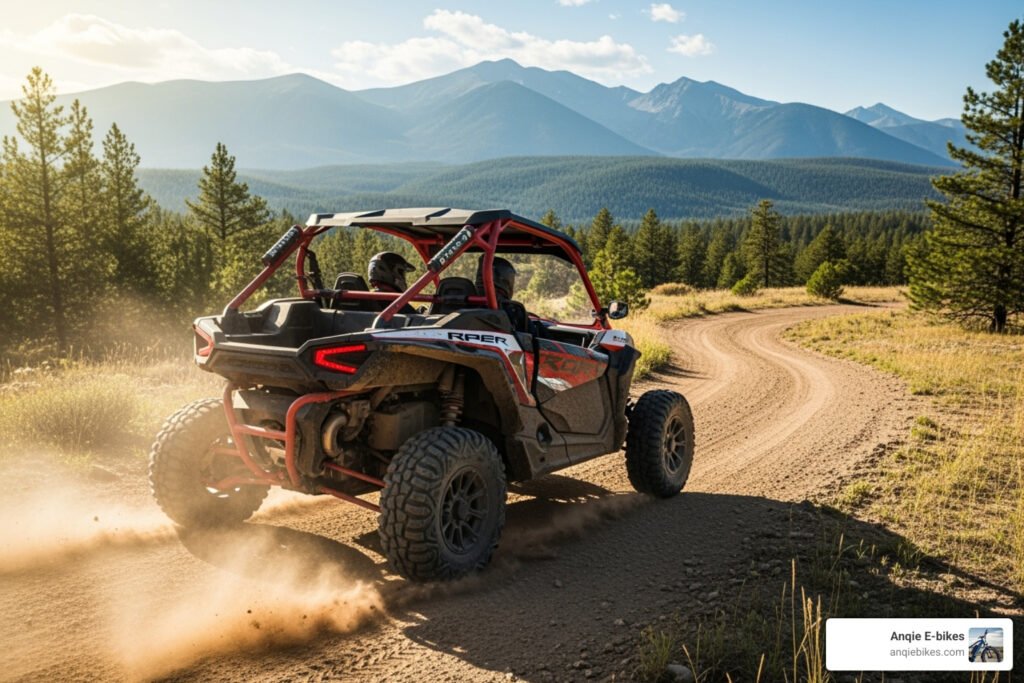What Is a Side-by-Side UTV?
A side by side UTV (Utility Terrain Vehicle) is an off-road vehicle designed with seats positioned side by side, a steering wheel, foot pedals, and a protective roll cage. Unlike traditional ATVs with saddle-style seats and handlebars, a UTV provides an automotive-like experience that offers improved safety and comfort for multiple passengers. This makes them ideal for families, work crews, or anyone wanting to share an off-road adventure.
These versatile machines are built for both work and recreation, boasting superior cargo and towing capacities compared to ATVs. They are the pickup trucks of the off-road world, capable of hauling supplies, transporting equipment, and carrying gear for any trip.
Key Features of Side-by-Side UTVs:
- Seating: 2-6 passengers seated side by side
- Controls: Steering wheel and foot pedals (not handlebars)
- Safety: Enclosed roll cage structure with seatbelts
- Capacity: Higher towing (1,500-4,500 lbs) and cargo capacity than ATVs
- Power: Gas, diesel, or electric engines ranging from 200cc to 1,000cc+
- Uses: Farm work, property management, hunting, trail riding, recreation
Types of Side-by-Side UTVs:
- Utility Models – Built for hauling, towing, and work tasks
- Sport Models – Designed for high-performance off-road riding
- Recreational Models – Balanced for comfort, versatility, and family use
The side-by-side market is experiencing significant growth. The global UTV market was valued at $10.5 billion in 2022 and is projected to reach $17.8 billion by 2030, growing at a rate of 6.8% annually. North America leads this market, driven by increasing demand for both recreational off-road activities and utility applications in agriculture and construction.
I’m Mark Stark, and I’ve spent years helping customers steer recreational vehicles and power equipment. Throughout my career in the electric bike and marine industry, I’ve guided countless buyers through the process of selecting the perfect side by side UTV for their specific needs, whether for ranch work, trail riding, or family adventures.
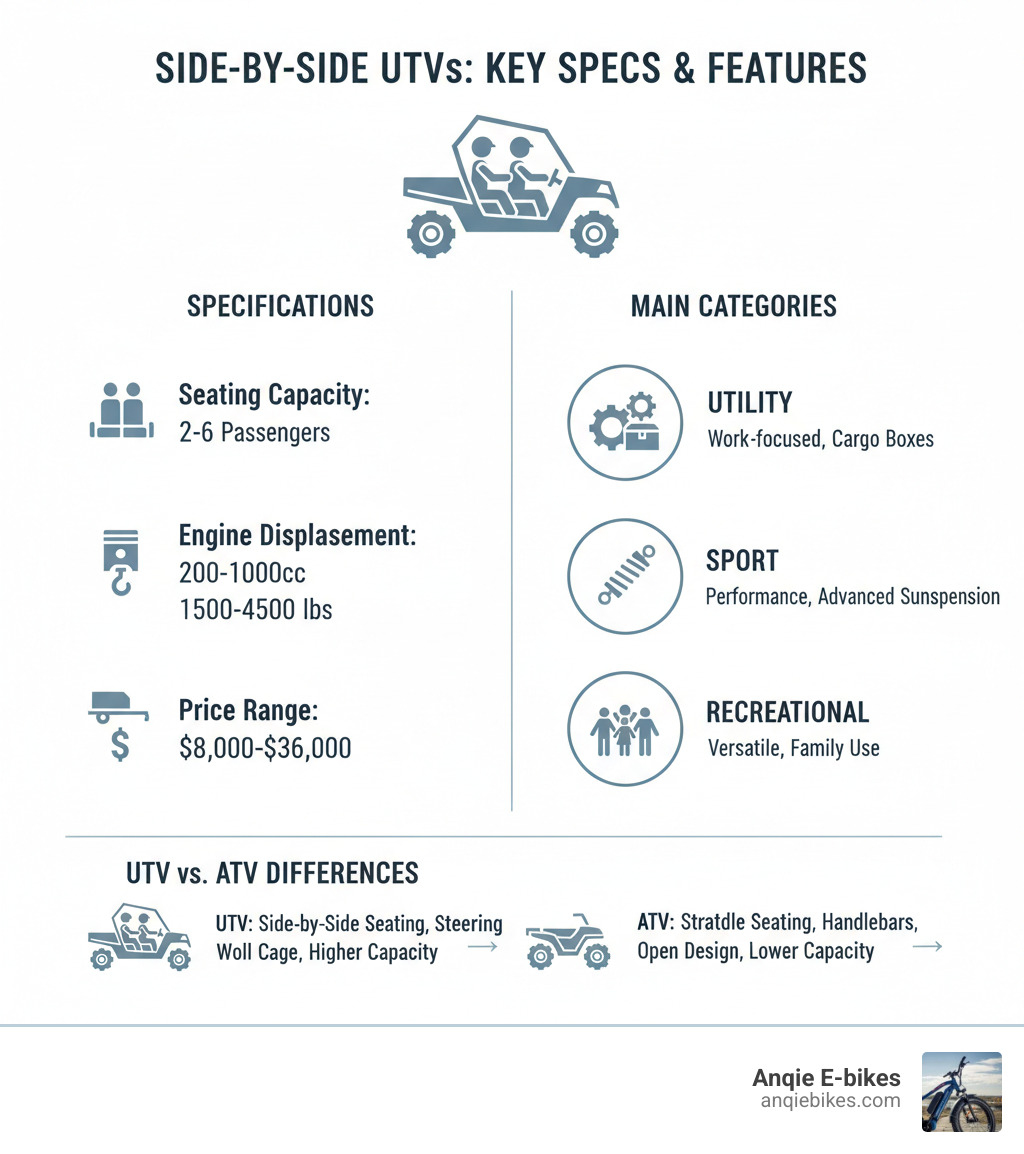
Decoding the Types and Uses of UTVs
Not all side by side UTVs are created equal. The market has evolved to meet diverse needs, from ranchers needing a workhorse to adventurers seeking thrills. Understanding these different types will help you find the perfect match.
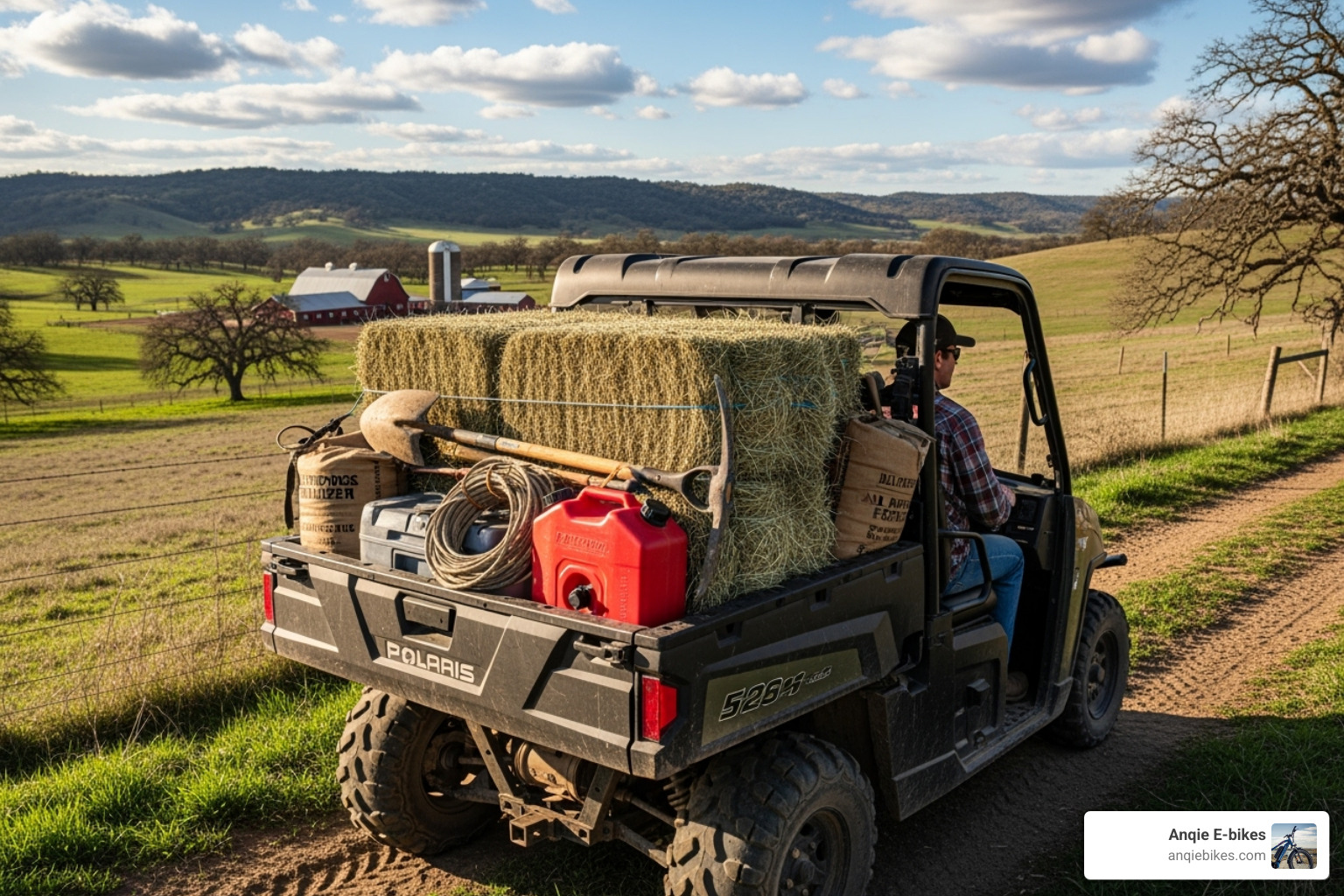
Types of Side-by-Side UTVs
UTV types fall along a spectrum, from pure utility to high-performance sport, with versatile recreational models in the middle. Many modern machines blur these lines, offering hybrid capabilities.
Utility models are the workhorses, built with one goal: getting work done. They feature robust cargo beds, engines tuned for torque over speed, and towing capacities that can reach 4,500 pounds. With features like dumping cargo boxes, they are perfect for farms, construction sites, and property management. If your UTV needs to earn its keep, this is your category.
Sport-inspired models are engineered for performance and adrenaline. They sacrifice some cargo capacity for lighter frames, responsive handling, and long-travel suspension designed to absorb punishment at high speeds. With engines often exceeding 80 horsepower, sport UTVs are built for carving through dunes, conquering rock crawls, and dominating off-road race courses, as seen in events like the Dakar Rally.
Recreational models offer the best of both worlds. These versatile side by side UTVs are designed for families and outdoor enthusiasts who want comfort, capability, and fun. They feature comfortable seating for multiple passengers, enough cargo space for coolers and camping gear, and a smooth ride on trails while still handling light utility tasks.
Key Applications from Work to Wilderness
The true magic of the side by side UTV lies in its incredible versatility across countless applications.
In agriculture and ranching, UTVs have revolutionized daily operations by moving hay, checking fences, and transporting feed more efficiently than traditional vehicles. Their ability to handle diverse terrain while carrying heavy loads is essential. For best practices, always review official guidelines for farm vehicle safety.
For property maintenance on large estates or commercial grounds, a UTV is an indispensable assistant for hauling equipment, towing trailers, and accessing remote areas.
Construction sites rely on UTVs to transport materials and workers across rough, unfinished terrain where larger vehicles would struggle.
For hunting and fishing, a side by side UTV provides access to remote locations. It can transport treestands, retrieve game, and haul gear to secluded spots, all while carrying everything you need in a single trip.
Trail riding represents pure recreational joy. Exploring scenic paths, tackling muddy challenges, or navigating desert landscapes with family and friends creates lasting memories.
Overlanding, or self-reliant adventure travel, has found a perfect companion in capable UTVs. They excel at carrying camping gear, extra fuel, and supplies for extended expeditions into the wilderness.
UTVs are also adopted for military reconnaissance, and emergency services use them for search and rescue in difficult terrain, proving just how adaptable these machines can be.
The Ultimate Buyer’s Checklist for a Side by Side UTV
Choosing the right side by side UTV can be overwhelming, but this checklist will help you steer the features and make an informed decision.
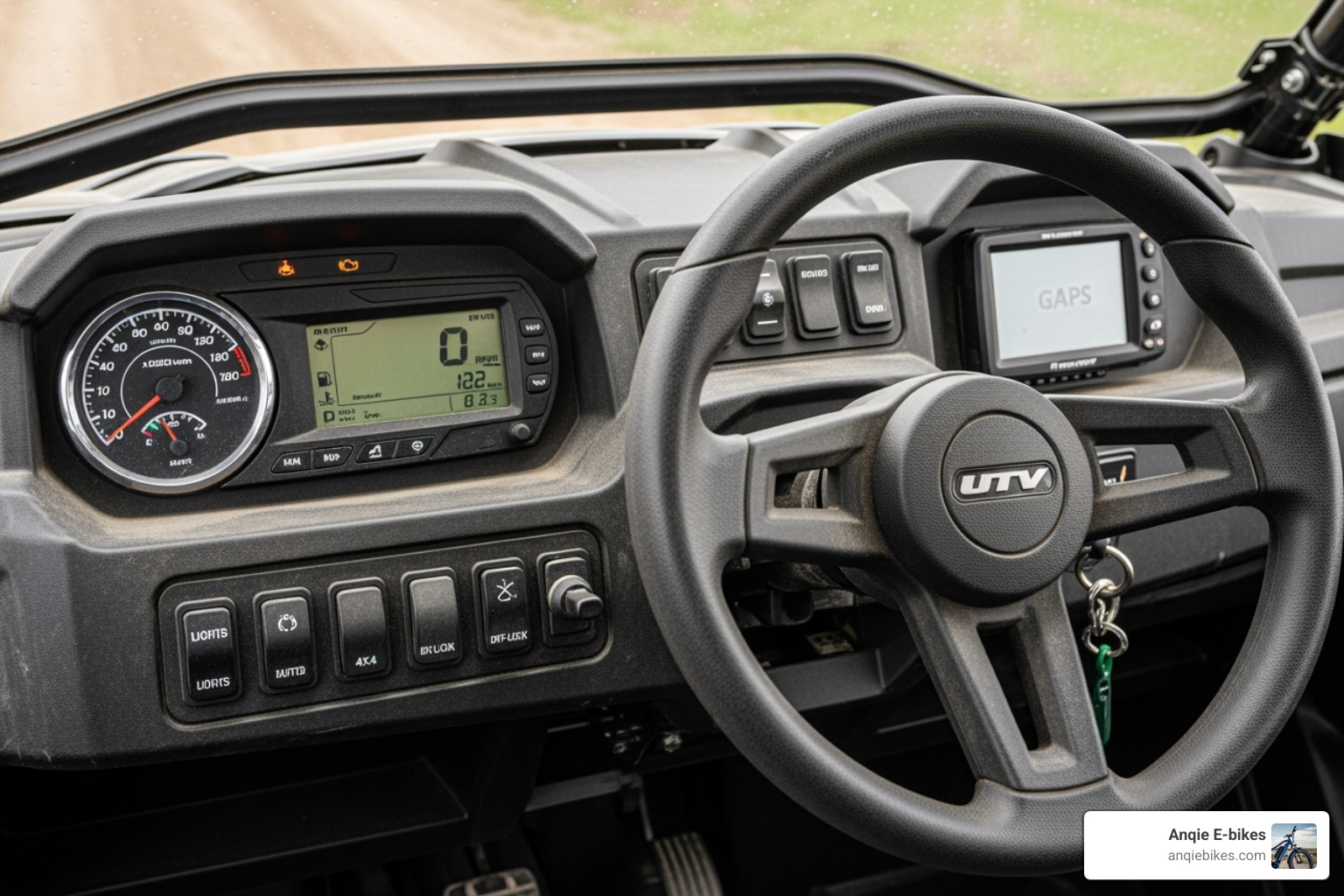
Performance and Capability
Understanding a UTV’s performance metrics is crucial for matching it to your intended use.
Engine size (CC), horsepower, and torque are the heart of your machine. Engine size (200cc to 1000cc+) gives a sense of power potential. Horsepower (from 44 HP to over 80 HP) relates to speed, while torque is about raw pulling power. A utility UTV prioritizes torque for work, while a sport model focuses on high horsepower for speed.
Gas and electric options both have advantages. Electric models offer quiet operation, instant torque, and reduced maintenance, but have range limitations. Gasoline models provide extended range and quick refueling. Your choice depends on whether you need sustained power for long workdays or quiet, clean operation.
Most UTVs offer selectable 2WD and 4WD for efficiency and traction. Advanced models include all-wheel drive (AWD) or locking differentials, which provide maximum traction by ensuring all wheels receive power, a game-changer for mud, snow, or extreme rock crawling.
Suspension travel and ground clearance are paramount for rough terrain. Suspension travel (how much the wheels move vertically) absorbs bumps for a smoother ride; look for 9 to 11 inches or more. Ground clearance (11 to 14 inches) is the distance from the vehicle’s underside to the ground, preventing scrapes on rocks and obstacles.
Towing and payload capacities are vital for work. Towing capacity (1,500 to 4,500 lbs) indicates how much weight the vehicle can pull. Payload capacity is the total weight the UTV can carry in its bed and cabin, including passengers and cargo. Never overload your machine, as it can cause damage and create dangerous situations.
Size, Comfort, and Features
Beyond raw power, a UTV’s practical features significantly impact your experience.
Vehicle dimensions matter for trail access and storage. Some trails have width restrictions, making a narrower side by side UTV essential. Overall length and height are also important for garage space and transport.
Seating capacity is a critical choice. Do you need a 2-seater for a passenger, a 4-seater for family trips, or a 6-seater for larger crews? More seats usually mean a longer wheelbase, which can affect maneuverability.
Modern cab features improve comfort and enjoyment. A roof offers sun and rain protection, while a windshield deflects debris and wind. Doors provide added security and weather protection.
Power steering is a highly recommended feature that reduces driver fatigue on long or technical rides. Premium models may even offer factory-installed heating and air conditioning, turning your UTV into an all-weather vehicle.
Budgeting for your side by side UTV
Purchasing a side by side UTV involves more than the sticker price. Consider the full financial picture to avoid surprises.
New versus used price ranges vary considerably. New UTVs range from around $8,000 to over $30,000. Used UTVs are more budget-friendly but require careful inspection for wear and tear. Always ask for service records.
The total cost of ownership includes fuel (or electricity), regular maintenance (oil changes, tires, brakes, belts), and potential repairs. Electric models may have lower maintenance costs but could require a costly battery replacement down the line.
Insurance costs protect your investment and vary based on location, vehicle value, and coverage. Get quotes before you buy.
Maintenance fees are an ongoing reality. Budget for routine servicing and wear-and-tear items to keep your machine running smoothly for years to come.
At Anqie E-bikes, we understand that navigating these decisions can feel complex. That’s why our team is here to provide expert guidance every step of the way, helping you find the perfect side by side UTV that fits both your needs and your budget.
Safety and Regulations: Riding Responsibly
The thrill of commanding a side by side UTV comes with real responsibility. These are powerful machines, and keeping yourself and your passengers safe requires preparation, proper equipment, and respect for the vehicle’s capabilities.
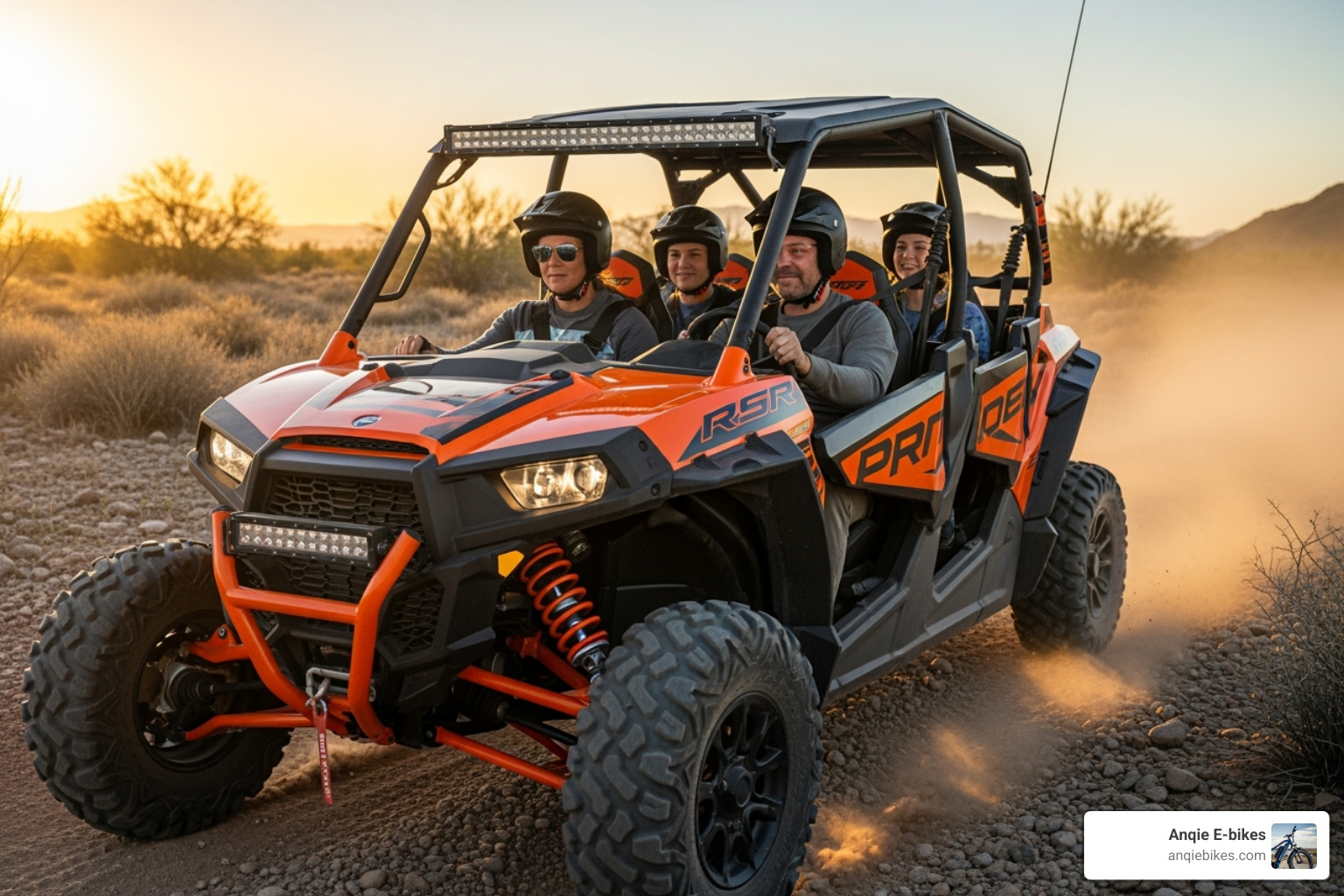
Essential Safety Practices
Before you head out, follow these safety essentials to ensure a great ride.
Helmets, goggles, and seatbelts are absolute necessities for every person in the UTV. The roll cage works best when you’re secured in your seat, and proper eye protection is crucial.
Protective clothing like long sleeves, long pants, gloves, and sturdy over-the-ankle boots creates a barrier between you and the elements.
Regarding age restrictions, most manufacturers recommend a minimum operating age of 16. Operating a side by side UTV requires mature judgment and coordination. Similarly, never exceed the manufacturer’s specified passenger limits, as overloading compromises handling and braking.
UTVs are designed for off-road use, not paved roads. Their suspension and tires are optimized for dirt, mud, and trails. Driving on pavement reduces stability, causes excessive tire wear, and is often illegal.
The U.S. Consumer Product Safety Commission (CPSC) has documented concerns about UTV stability and rollover risks, noting 116 deaths in ROV/UTV accidents between 2003 and August 2009. These are reminders to operate within your skill level and your vehicle’s limits. Avoid sharp turns at high speeds and overly steep side hills. For comprehensive guidelines, review the information provided by the CPSC Recreational Off-Highway Vehicle Info.
Understanding the Rules of the Road (and Trail)
Legal requirements for operating a side by side UTV vary dramatically by location, so understanding your local rules is essential.
State regulations on street legality are inconsistent. Some states allow limited on-road use if the UTV is modified with turn signals, horns, mirrors, and proper registration. Others strictly prohibit UTVs on public roads. Check with your local DMV for specific requirements.
Many public trail systems require trail permits. These fees fund trail maintenance, keeping riding areas safe and accessible for everyone.
Registration requirements may apply even if you only ride on private property. Most states have off-highway vehicle (OHV) programs that require registration, which helps track vehicles and fund public lands.
Industry standards from ANSI (American National Standards Institute) define UTV categories based on speed, width, and weight. These standards often form the basis for state regulations, so understanding them helps you stay compliant.
At Anqie E-bikes, we believe that responsible riding protects the entire off-road community. Following safety practices and respecting regulations preserves access to the trails we all cherish.
Frequently Asked Questions about Side-by-Side UTVs
Over the years, I’ve had countless conversations with folks who are just starting to explore side by side UTVs. The questions tend to follow similar patterns, and I find that these are the ones that come up most frequently. Let me share the answers that I’ve found most helpful in guiding customers toward the right decision.
What is a side-by-side UTV?
A side by side UTV is an off-road vehicle with a distinctive seating arrangement where passengers sit next to each other. It features a steering wheel, foot pedals, and a protective roll cage with seatbelts. What sets them apart is their versatility for both work and recreation. Compared to an ATV, a UTV offers more cargo capacity, higher towing capability, and the ability to comfortably transport multiple passengers, making it a powerful and practical choice for property owners and adventurers alike.
What is the average cost of a new side-by-side UTV?
New side by side UTV prices vary considerably. Entry-level utility models typically start around $8,000. Mid-range recreational models usually fall in the $12,000 to $20,000 range, while high-performance sport models or fully-loaded utility UTVs with premium features can exceed $30,000. The final price depends on factors like engine size, horsepower, suspension quality, seating capacity, and premium features like power steering or enclosed cabs. There is a model for nearly every budget.
Are side-by-side UTVs street legal?
This is a complicated question, as the rules depend entirely on your location. Street legality for side by side UTVs varies from state to state, and even county to county. Many areas restrict UTVs to off-road use only. However, some states have carved out specific regulations that allow limited on-road operation. In these locations, you’ll typically need to register your UTV, and the vehicle must be modified to meet certain requirements. Common modifications include adding turn signals, a horn, mirrors, a license plate light, and DOT-approved tires. Before you even consider taking your UTV onto a public road, I always recommend contacting your local Department of Motor Vehicles or your state’s off-highway vehicle program office. They can provide the exact requirements for your area. Even if street use isn’t allowed, many states still require registration for off-road UTVs, so it’s worth understanding the complete legal picture. Safety and compliance go hand in hand, and knowing the rules protects both you and your investment.
Conclusion: Finding Your Perfect Off-Road Companion
You’ve traveled through side by side UTVs with us, and now it’s time to bring it all together. We’ve explored everything from utility workhorses to high-performance sport models, discussed essential features from engine size to suspension travel, and covered the safety practices that keep every ride enjoyable.
The truth is, there’s no single “best” UTV out there. The perfect side by side UTV for you is the one that fits seamlessly into your life. Are you a rancher who needs to haul supplies across vast acreage? A thrill-seeker who dreams of conquering sand dunes? A family looking to explore forest trails together on weekends? Your answer to these questions will guide you toward the right machine.
Take a moment to review our buyer’s checklist. Think about performance metrics like horsepower and torque if you need power, or focus on seating capacity and comfort features if family adventures are your priority. Consider your budget realistically, remembering that the total cost includes insurance, maintenance, and those fun accessories you’ll inevitably want to add.
When you’re ready to buy, you have options. Dealerships offer the advantage of warranties, financing, and professional service departments. Private sales might save you money upfront. Whichever route you choose, don’t overlook the value of after-sales support. Having access to knowledgeable staff, genuine parts, and reliable maintenance services can transform your ownership experience from frustrating to fantastic.
At Anqie E-bikes, we’ve built our reputation on exceptional customer service and expert guidance. While we specialize in e-bikes and marine products, we understand the broader world of recreational vehicles and the passion that drives people to explore off-road. Whether you’re in Brooklyn, NY, or beyond, we’re committed to helping you find equipment that matches your adventures and supporting you every step of the way.
The right side by side UTV is waiting for you. It’s not just about specifications on paper – it’s about the experiences you’ll have, the work you’ll accomplish, and the memories you’ll create. Match the UTV to your lifestyle, prioritize your actual needs over flashy features you won’t use, and choose a seller who’ll stand behind you after the sale.
Ready to start your off-road journey? We invite you to explore quality options like the Trailmaster Challenger, which offers impressive capability at a great value. Ready to explore? Check out our Trailmaster Challenger 300 EFI Side-by-Side!
Your perfect off-road companion is out there. Let’s help you find it.
